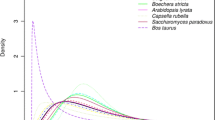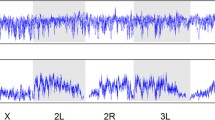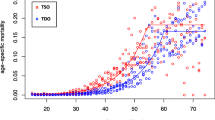Abstract
Preservation of genetic diversity is of fundamental concern toconservation biology, as genetic diversity is required for evolutionarychange. Predictions of neutral theory are used to guide conservationactions, especially genetic management of captive populations ofendangered species. Loss of heterozygosity is predicted to be inverselyrelated to effective population size. However, there is controversy asto whether allozymes behave as predicted by this theory. Loss of geneticdiversity for seven allozyme loci, chromosome II inversions andmorphological mutations was investigated in 23 Drosophilamelanogaster populations, maintained at effective population sizesof 25 (8 replicates), 50 (6), 100 (4), 250 (3) and 500 (2) for 50generations. Allozyme genetic diversity (heterozygosity, percentpolymorphism and allelic diversity), inversions and morphologicalmutations were all lost at greater rates in smaller than largerpopulations. Conservation concerns about loss of genetic diversity insmall populations are clearly warranted. Across our populations, loss ofallozyme heterozygosity over generations 0–24, 0–49 and25–49 did not differ from the predictions of neutral theory. Thetrend in deviations was always in the direction expected withassociative overdominance. Our results support the use of neutral theoryto guide conservation actions, such as the genetic management ofendangered species in captivity.
Similar content being viewed by others
References
Ayala FJ, Campbell CA (1974) Frequency-dependent selection. Annu. Rev. Ecol. Syst., 5, 115–138.
Ballou JD, Foose TJ (1996) Demographic and genetic management of captive populations. In: Wild Animals in Captivity: Principles and Techniques (eds. Kleiman DG, Allen ME, Thompson KV, Lumpkin S), pp. 263–283. University of Chicago Press, Chicago.
Ballou J, Lacy RC (1995) Identifying genetically important individuals for management of genetic diversity in pedigreed populations. In: Population Management for Survival and Recovery: Analytical Methods and Strategies in Small Population Conservation (eds. Ballou J, Gilpin M, Foose T), pp. 76–111. Columbia University Press, New York.
Begun DJ, Aquadro CF (1992) Levels of naturally occurring DNA polymorphism correlate with recombination rates in D. melanogaster. Nature 356, 519–520.
Borlase SC, Loebel DA, Frankham R, Nurthen RK, Briscoe DA, Daggard GE (1993) Modeling problems in conservation genetics using captive Drosophila populations: consequences of equalization of family sizes. Conserv. Biol., 7, 122–131.
Briscoe DA, Malpica JM, Robertson A, Smith GJ, Frankham R, Banks RG, and Barker JSF (1992) Rapid loss of genetic variation in large captive populations of Drosophila flies: Implications for the genetic management of captive populations. Conserv. Biol., 6, 416–425.
Briton J, Nurthen RK, Briscoe DA, Frankham R (1994) Modelling problems in conservation genetics using captive Drosophila populations: Consequences of harems. Biol. Conserv., 69, 267–275.
Brookfield JFY, Sharp PM (1994) Neutralism and selectionism face up to DNA data. Trend. Genet., 10, 109–111.
Brown A, Young A, Burdon J, Cristidis L, Clarke G, Coates D, Sherwin W (1997) Genetic Indicators for State of the Environment Reporting. Australia: State of the Environment Technical Paper Series (Environmental Indicators). Department of Environment, Sport and Territories, Canberra, Australia.
Crow JF, Kimura M (1970) An Introduction to Population Genetics Theory. Harper & Row, New York.
Cruden D (1949) The computation of inbreeding coefficients in closed populations. J. Hered., 40, 248–251.
Dobzhansky T, Pavlovsky O (1957) An experimental study of the interaction between genetic drift and natural selection. Evolution, 11, 311–319.
Dobzhansky T, Ayala FJ, Stebbins GL, and Valentine JW (1977) Evolution. W.H. Freeman, San Francisco.
Ellstrand NC, Elam DR (1993) Population genetic consequences of small population size: Implications for plant conservation. Annu. Rev. Ecol. Syst., 24, 217–242.
Eriksson K, Halkka O, Lokki J, Saura A (1976) Enzyme polymorphism in feral, outbred and inbred rats (Rattus norvegicus). Heredity, 37, 341–349.
Falconer DS, Mackay TFC (1996) Introduction to Quantitative Genetics, 4th edn. Longman, Harlow, England.
Fitch WM, Atchley WR (1985) Evolution in inbred strains of mice appears rapid. Science, 228, 1169–1175.
Frankel OH, Soulé ME (1981) Conservation and Evolution. Cambridge University Press, Cambridge.
Frankham R (1995a) Conservation genetics. Annu. Rev. Genet., 29, 305–327.
Frankham R (1995b) Effective population size / adult population size ratios in wildlife: a review. Genet. Res., 66, 95–107.
Frankham R (1996) Relationship of genetic variation to populations size in wildlife. Conserv. Biol., 10, 1500–1508.
Frankham R (2000) Modeling problems in conservation genetics using laboratory animals. In: Quantitative Methods in Conservation Biology (eds. Ferson S, Burgman M), pp. 259–273. Springer-Verlag, New York.
Frankham R, Manning H, Margan SH, David A. Briscoe DA (2000) Does equalisation of family sizes reduce genetic adaptation to captivity? Animal Conservation (in press).
Franklin IR (1980) Evolutionary change in small populations. In: Conservation Biology: An Evolutionary Ecological Perspective (eds. Soulé, ME, Wilcox BA), pp. 135–149. Sinauer, Sunderland, MA.
Gillespie JH (1991) The Causes of Molecular Evolution. Oxford University Press, New York.
Hey J (1999) The neutralist, the fly and the selectionist. Trends Ecol. Evol., 14, 35–38.
Hoffmann AA, Parsons PA (1991) Evolutionary Genetics and Environmental Stress. Oxford University Press, Oxford.
Karl SA, Avise JC (1992) Balancing selection at allozyme loci in oysters: Implications from nuclear RFLPs. Science 256, 100–102.
Kimura M (1983) The Neutral Theory of Molecular Evolution. Cambridge University Press, Cambridge.
Kreitman M (1996) The neutral theory is dead. Long live the neutral theory. BioEssays, 18, 678–683.
Kreitman M, Akashi H (1995) Molecular evidence for natural selection. Annu. Rev. Ecol. Syst., 26, 403–422.
Latter BDH. (1998) Mutant alleles of small effect are primarily responsible for the loss of fitness with slow inbreeding in Drosophila melanogaster. Genetics 148, 1143–1158.
Latter BDH, Mulley JC, Reid D, Pascoe L (1995) Reduced genetic load revealed by slow inbreeding in Drosophila melanogaster. Genetics 139, 287–297.
Leberg PL (1992) Effects of population bottlenecks on genetic diversity as measured by allozyme electrophoresis. Evolution 46, 477–494.
Lewontin RC (1974) The Genetic Basis of Evolutionary Change. Columbia University Press, New York.
Lindsley DL, Zimm GG (1992) The Genome of Drosophila melanogaster. Academic Press, San Diego.
McNeely JA, Miller KR, Reid WV, Mittermeier RA, Werner TB (1990) Conserving the World's Biological Diversity. IUCN, World Resources Institute, Conservation International, WWFUS and the World Bank, Washington, DC.
Mina, NS, Sheldon, BL, Yoo BH, Frankham R (1991) Heterozygosity at protein loci in inbred and outbred lines of chickens. Poult. Sci., 70, 1864–1872.
Nei M, Graur D (1984) Extent of protein polymorphism and the neutral mutation theory. Evol. Biol., 17, 73–118.
Nevo E, Bieles A, Ben-Shlomo R (1984) The evolutionary significance of genetic diversity: ecological, demographic and life history correlates. In: Evolutionary Dynamics of Genetic Diversity (ed. Mani GS), pp. 13–213. Springer-Verlag, Berlin.
Ohta T (1992) The near neutral theory of molecular evolution. Annu. Rev. Ecol. Syst., 23, 263–286.
Ohta T (1996) The current significance and standing of neutral and near neutral theories. BioEssays, 18, 673–677.
Pogson GH, Zouros E (1994) Allozyme and RFLP heterozygosities as correlates of growth rate in the scallop Placopecten magellanicus: a test of the associative overdominance hypothesis. Genetics 137, 221–231.
Raybould AF, Mogg RJ, CLarke RT (1996) The genetic structure of Beta vulgaris ssp. maritime (sea beet) populations: RFLPs and isozymes show different patterns of gene flow. Heredity, 77, 245–250.
Richardson BJ, Baverstock PR, Adams M (1986) Allozyme Electrophoresis: A Handbook for Animal Systematics and Population Studies. Academic Press, Sydney, Australia.
Robertson A (1962) Selection for heterozygotes in small populations. Genetics, 47, 1291–1300.
Rumball W, Franklin IR, Frankham R, Sheldon BL (1994) Decline in heterozygosity under full-sib and double first-cousin inbreeding in Drosophila melanogaster. Genetics, 136, 1039–1049.
Ryan BF, Joiner BL (1994) MINITAB Handbook, 3rd edn. Duxbury Press, Belmont, California.
Satta Y, O'Huigin C, Takahata N, Klein J. (1994) Intensity of natural selection at the major histocompatibility complex loci. Proc. Natl. Acad. Sci. USA, 91, 7184–7188.
Sing CF, Brewer GJ, Thirtle B (1973) Inherited biochemical variation in Drosophila melanogaster: Noise or signal? I. Singlelocus analyses. Genetics, 75, 381–404.
Soulé ME (1976) Allozyme variation, its determinants in space and time. In: Molecular Evolution (ed. Ayala FJ), pp. 60–77. Sinauer, Sunderland, MA.
Soulé ME, Gilpin M, Conway W, Foose T (1986) The millenium ark: how long a voyage, how many staterooms, how many passengers? Zoo Biol., 5, 101–113.
Strauss SH (1986) Heterosis at allozyme loci under inbreeding and crossbreeding in Pinus attenuata. Genetics, 113, 115–134.
Woodworth LM (1996) Population Size in Captive Breeding Programs. PhD thesis, Macquarie University, Sydney, Australia.
Woodworth LM, Montgomery ME, Nurthen RK, Briscoe DA, Frankham R (1994) Modelling problems in conservation genetics using Drosophila: consequences of fluctuating population sizes. Mol. Ecol., 3, 393–399.
Wright S (1931) Evolution in Mendelian populations. Genetics, 16, 97–159.
Yeh FC, Scheinberg E (1972) Inbreeding as a control of biochemical polymorphism in populations of Tribolium castaneum. Can. J. Genet. Cytol., 14, 741.
Author information
Authors and Affiliations
Corresponding author
Rights and permissions
About this article
Cite this article
Montgomery, M.E., Woodworth, L.M., Nurthen, R.K. et al. Relationships between population size and loss of genetic diversity: comparisons of experimental results with theoretical predictions. Conservation Genetics 1, 33–43 (2000). https://doi.org/10.1023/A:1010173401557
Issue Date:
DOI: https://doi.org/10.1023/A:1010173401557




